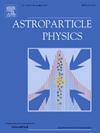f(Q)引力框架下现实中子星的演变
IF 2.9
3区 物理与天体物理
Q1 ASTRONOMY & ASTROPHYSICS
引用次数: 0
摘要
在f(Q)引力框架中,我们选择了各向异性运动方程,并确定f(Q)是非度量Q的线性函数。为了评估我们工作中的场方程,我们选择使用Krori-Barua度量。我们分别计算了四个紧凑天体的各向异性因子,发现各向异性分量为正且单调增加,从而解释了核力可以对抗引力。最后,我们确定了质量与半径之间的关系,并以直观的方式进行了说明。我们注意到,脉冲星 LMC X-4、SMC X-4、Cen X-3 和 Vela X-1 在不同的 a 值下,其紧凑程度都在布赫达尔极限之内。此外,我们还计算了模型质量,并使用 30 种不同的 a 值进行了 Chi-Square 检验,以确定观测质量和模型质量之间是否存在明显差异。我们还研究了表面红移随时间的变化情况,以及模型中先前描述的紧凑天体是否紧凑。本文章由计算机程序翻译,如有差异,请以英文原文为准。
Evolution of realistic neutron star in the framework of f(Q) gravity
This work analyzes and evaluates a few realistic compact objects in the presence of a gravitational interaction between two particles with a nonmetricity . In the gravity framework, we have selected the anisotropic equation of motion and have determined to be a linear function of nonmetricity . To evaluate the field equations in our work, we have opted to employ the Krori–Barua metric. We calculated the anisotropic factor for each of the four compact objects and found that the anisotropic component is positive and increases monotonically and interpreted that the nuclear force can oppose the gravitational attraction. At last, the relationship between mass and radius has been determined and illustrated visually. We have noted that the compactness of the pulsars LMC X-4, SMC X-4, Cen X-3, and Vela X-1 is inside the Buchdahl’s limit for varying values of . This has led to the interpretation that these pulsars are neutron stars in a modified gravity background of . In addition, we calculated the model mass and, using thirty distinct choices of , ran the Chi-Square test to see if there was a noticeable difference between the observed and model-generated masses. We have also looked at how the surface redshift has changed over time and whether the compact objects in our model that were previously described are compact.
求助全文
通过发布文献求助,成功后即可免费获取论文全文。
去求助
来源期刊

Astroparticle Physics
地学天文-天文与天体物理
CiteScore
8.00
自引率
2.90%
发文量
41
审稿时长
79 days
期刊介绍:
Astroparticle Physics publishes experimental and theoretical research papers in the interacting fields of Cosmic Ray Physics, Astronomy and Astrophysics, Cosmology and Particle Physics focusing on new developments in the following areas: High-energy cosmic-ray physics and astrophysics; Particle cosmology; Particle astrophysics; Related astrophysics: supernova, AGN, cosmic abundances, dark matter etc.; Gravitational waves; High-energy, VHE and UHE gamma-ray astronomy; High- and low-energy neutrino astronomy; Instrumentation and detector developments related to the above-mentioned fields.
 求助内容:
求助内容: 应助结果提醒方式:
应助结果提醒方式:


